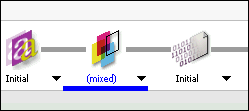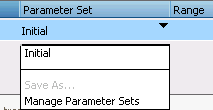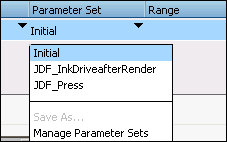Multi-part Jobs in the Plan Tab
The Production Plan visually highlights with a thick blue underscore those operations that have different processing settings defined.
 |
TIP: You can only specify different settings for specific Task Processors.
When you add a Task Processor to a plan, it has by default the same settings for the whole job (i.e, it is set to single processing). To specify different settings, select the Different Processing option in the header of the Settings pane. A production sets table is then displayed, listing the different production sets, including ranges and parts, as defined in the Products tab.
 |
NOTE: You cannot manage productions sets from here.
The single processing set is used as the default set for when you create new production sets. Apogee copies the parameter values used for the single processing mode to each production set. You can switch back and forth between the two modes without loosing any edits.
When you create a new production set (in the Products tab), it becomes visible to all operations that support it (and that have Different Processing selected). See “Managing Production Sets”.
The Parameter Set column displays the selected parameter set(s). You can select a different parameter set from the drop-down list, or change the name (by double clicking it).
 |
Press and Output Task Processors feature an extra Device column from which you can select the device you want to use. By default, the device and parameter selection are identical for all production sets, and matches the device and parameter set that was selected in single processing mode.
 |
NOTE: Since JDF has no names for a set of parameters, Apogee uses generic names for displaying the parameter set name. This generic name is of the form JDF Set, optionally followed by space and a number to differentiate different parameter values for different production sets.
The Parameter Set Drop-down menu
You can change the parameter set in the flow by selecting another from the Parameter Set drop down list. This assigns the selected parameter set to all production sets.
 |
Save As
To save the parameter set, select Save As. Apogee prompts for a name, after which it saves the current values as a parameter set with the given name. Doing so also sets the current selection to the newly created parameter set.
Manage Parameter Sets
Select this item to open the Parameter Sets Resource overview, with the current operation selected (Administrator only).
Output
•CtP, CtF and Proofers: If you select Different Settings in the Output operation, you automatically select them for the Image parameters as well. This is because the image parameters of a production set must always correspond to the selected output device. However, you can only switch between devices of the same class (CtP, CtF or Proofer).
•Press: The parameter view of the Press task processor presents the different press task processors in the production set table, allowing you to select a particular one. The Generic Press task processor only offers parameter sets.
The Run List Task Processor
•General settings: The Number of Pages option is shared with the corresponding item in the Products tab: You can change its value in either place. The effects of changing it is the same as with previous versions of Apogee.
The First page starts at option is not available in multi-part jobs with multiple parts. Instead, it is set to `1'. It is enabled if the job has a single part.
•Hard copy proofing: Introducing production sets removes the need to have multiple proofing flows, one for every press flow. When you set the parameter set of the press in the proofing flow to (from main), the proofer press follows the settings from the main press, including the set up for different processing. If you do not use (from main), you will have to manually specify the parameters for the different processing.
doc. version 13.1.1